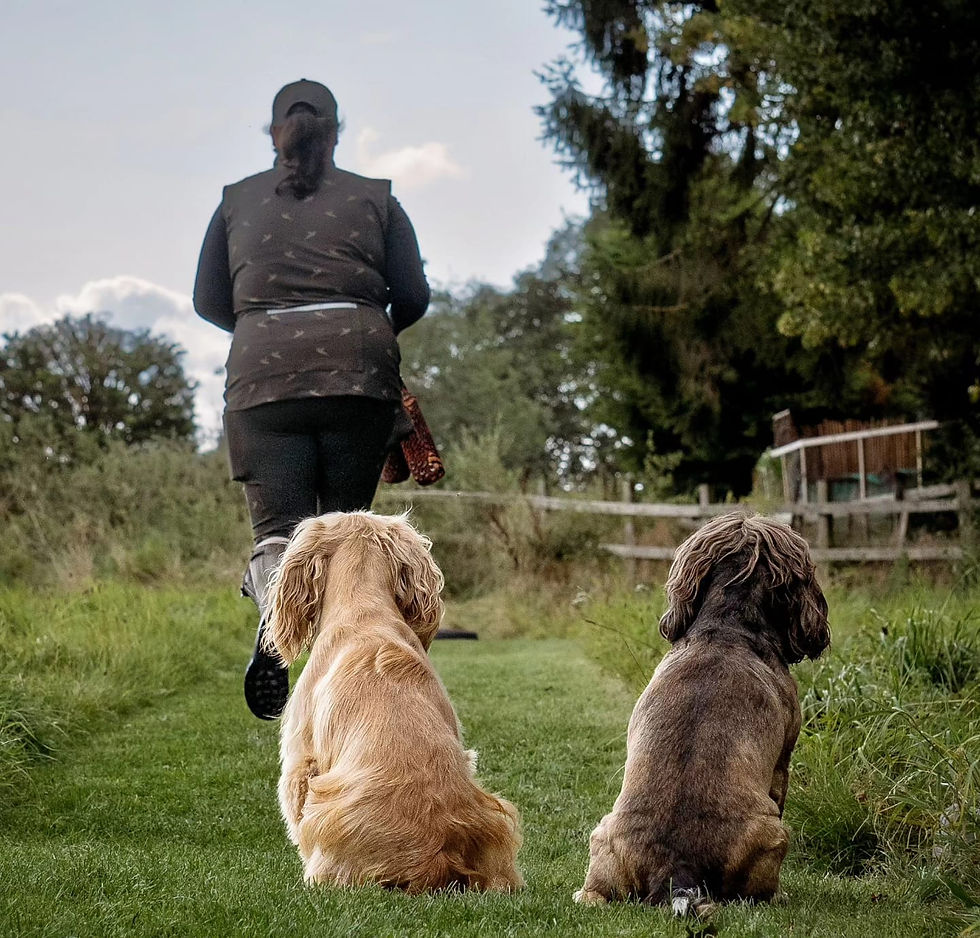
When we picture a well-trained gundog, we often think of their keen sense of smell, sharp retrieving skills, and unwavering loyalty. But there’s one trait that’s absolutely crucial, though it sometimes doesn’t get the attention it deserves: steadiness. Steadiness is the backbone of a gundog’s training, ensuring that your canine companion stays calm, focused, and in control, no matter what’s happening around them. Whether you’re working with a retriever, spaniel, or HPR, a steady dog is an absolute game-changer.
What Exactly Is Steadiness?
Steadiness, simply put, is your dog’s ability to stay put and composed in various situations. Imagine your dog sitting quietly as a bird flushes nearby, waiting patiently for your cue before charging off after the game, or staying glued to your side when distractions are at their peak. A steady dog is one that listens attentively, prioritises patience over impulse, and ultimately makes every day in the field more enjoyable and successful.
In a nutshell, steadiness is about trust. You trust your dog to stay where they’ve been told, and they trust that when it’s time to move, you’ll give them the go-ahead. A steady dog is not only safer in the field but also a pleasure to work with, showcasing the kind of discipline and focus that sets them apart from the rest.
Why Does Steadiness Matter?
For those who are just starting out in the world of gundogs, the sight of your dog eagerly showing off their hunting skills is undeniably thrilling. But without steadiness, that excitement can quickly spiral into chaos. A dog that breaks too soon can disrupt a shoot, scare off game, or, even worse, put themselves in dangerous situations. If you’re entering competitions, lack of steadiness can lead to disqualification, making it a vital skill for success.
Steadiness is also crucial for safety—both for your dog and everyone else in the field. Picture a scenario where several dogs are working together. An unsteady dog might cause a domino effect, leading to a situation where dogs are clashing or interfering with each other’s work. This not only makes things less effective, but also raises the risk of injury.
Fun Drills to Boost Your Dog’s Steadiness
Now that we’ve highlighted why steadiness is so important, let’s dive into some practical, and dare we say, fun drills that can help instil this quality in your gundog. These exercises are designed to build control, patience, and trust between you and your dog, turning training time into a rewarding experience for both of you.
1. The Sit Drill
Let’s start with a classic that never goes out of style—the Sit Drill. This is a fundamental exercise that teaches your dog to stay put until you give them the green light. Begin by asking your dog to sit, making sure it has its bottom and all four paws on the ground. Start with short durations and minimal distractions, then gradually up the ante by increasing the time and introducing distractions like clapping, walking away, or tossing a dummy nearby.
The trick here is consistency. Always return to the dog to reward it initially for the sit and release the dog from the sit using another command ie asking your dog to heel or to go for a retrieve. With regular practice, your dog will learn that sitting tight is the name of the game, no matter what temptations are thrown their way.
2. The Heel Work Drill
Heel work is a fantastic way to reinforce steadiness while your dog is on the move. It’s all about keeping your dog close, maintaining a steady pace, and resisting the urge to pull ahead or wander off track.
Start by walking your dog on a lead, using the ‘heel’ command to keep them right beside you. Gradually introduce distractions like other dogs, birds, or people to see how well your dog stays focused. The goal is for your dog to stick to your side, come what may. As your dog gets the hang of it, you can move to off-lead heel work in a safe, enclosed area. Remember, the key is consistency—your dog needs to know that the rules don’t change whether they’re standing still or on the move.
3. The Delayed Retrieve Drill
Once your dog is a pro at the basics of steadiness, it’s time to take things up a notch with the Delayed Retrieve Drill. This exercise tests your dog’s patience by requiring them to wait before retrieving a dummy.
Start with a short delay—just a few seconds will do—and gradually build up to a minute or more. The idea is to keep your dog guessing so they don’t anticipate the command. By making them wait, you’re teaching your dog that the retrieve is a reward for their patience and self-control, not something they’re entitled to immediately.
For an extra challenge, try walking away from your dog during the delay or adding multiple dummies. This ramps up the difficulty and reinforces the importance of waiting for your cue.
Wrapping Up
Steadiness isn’t just a nice-to-have trait in gundogs; it’s a must-have for anyone who wants a disciplined and dependable partner in the field. By focusing on drills that build patience, control, and obedience, you’ll develop a dog that’s not only steady but also confident in their role. Whether you’re training for trials or simply looking to enjoy more organised and safe experience on a shoot, prioritising steadiness is sure to pay off.
At Byron Gundogs, we believe a steady dog is the cornerstone of effective training. Incorporate these drills into your routine, and you’ll be well on your way to nurturing the kind of steadiness that makes a gundog truly exceptional. Happy training!

Comments